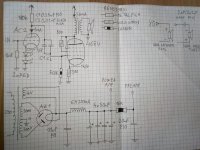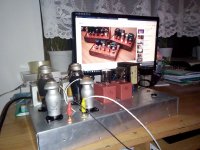Hi guys, Im 15 year old student from Czech Republic interested in single ended tube amps and high efficiency open baffle speakers. I built amplifier with 4654 output tube, triode strapped, and AC2 as a preamp. The schematic is old, these things I added: -another choke in power supply instead of 16k resistor -500ohm resistor in 4654 cathode instead of 300ohms. AC2 has LED bias, this was improvement in sound, REMA output transformers, AZ1 telefunken rectifier. Things I want to try: Hazen grid mod. Has anyone tried this? What do you thing about Hazen mod and my whole amp? Have you some another ideas, what to try for another sonic improvement?
regards
Michal
regards
Michal
Attachments
Nice Amp with a lot of retro look. IMHO, You didn't get much response because the Hazen mod is really subjective. What it does is to float the output tube's suppression grid and AC tie it to the cathode. If I were to do it (I didn't brother), I would make sure I hook a scope to the amp for a long long time to make sure there are no parasitic oscillation before leaving it in.What do you thing about Hazen mod and my whole amp?
Hello, thank you for reply. I learned about Hazen mod couple days ago, some people says that it is the best mod they did to their amp. As I can see, they arent much people that tried this....Nice Amp with a lot of retro look. IMHO, You didn't get much response because the Hazen mod is really subjective. What it does is to float the output tube's suppression grid and AC tie it to the cathode. If I were to do it (I didn't brother), I would make sure I hook a scope to the amp for a long long time to make sure there are no parasitic oscillation before leaving it in.
Have you tried anything?
Thank you for reply, regards Michal
Open baffle speakers greatly complicate the issue, but you *may* (or may not!) prefer the output stage cathode resistors paralleled by a bypass capacitor. The lack of a capacitor here increases the amplifier's source impedance; normally a bad thing, but may help in maintaining low frequency response in an open baffle. Worth trying, if only for information.
All good fortune,
Chris
All good fortune,
Chris
Fixed bias will have the same source impedance as a properly bypassed cathode resistor, but you'll gain some B+ voltage, which, as they say, can't hurt.
The "ideal" solution is to make the output impedance low, for compatability with a variety of speakers, and to add, "upstream", a frequency response tailored to your particular speakers. Not really necessary in an experimental and learning situation; only for reference.
All the best fortune,
Chris
The "ideal" solution is to make the output impedance low, for compatability with a variety of speakers, and to add, "upstream", a frequency response tailored to your particular speakers. Not really necessary in an experimental and learning situation; only for reference.
All the best fortune,
Chris
Increasing the final stage's source impedance makes the bass boomy, hence louder maybe, but has nothing to do with true reproduction.Open baffle speakers greatly complicate the issue, but you *may* (or may not!) prefer the output stage cathode resistors paralleled by a bypass capacitor. The lack of a capacitor here increases the amplifier's source impedance; normally a bad thing, but may help in maintaining low frequency response in an open baffle. Worth trying, if only for information.
Best regards!
Compatability with a wide variety of speakers requires a low source impedance (what other standard could practically be designed to?), but I get the impression that the OP is experimenting within a specific subset, his own speakers.Increasing the final stage's source impedance makes the bass boomy, hence louder maybe, but has nothing to do with true reproduction.
The OP's open baffle speakers need a huge bass boost from somewhere, to compensate for cancellation loss, so maybe the OP's is a special case. Dunno, maybe. Maybe not.
All the best,
Chris
Hmm, I didnt use anything like equalisers, bass boosts etc. I dont want to damage my speakers. Yes, it does not go deep with bass, but some bass are present! Probably the speakers in this enclosure ( i will made bigger open baffle with Tesla aro 835 on bass) plays only harmonics of the main frequency. If amp sends to speakers 60Hz bass, the speakers plays, for example 30% this frequency, and rest 70% is harmonic tone 120Hz. So, I hear information "there is some bass", but its not that powerful as it can be. Is it possible?
Hello MikyK,
You have build a really nice amp ! And I like the way you approach reproducing music, it took me many years to conclude that "less is more" and you just start there .
Regarding the bass response, the problem with open baffle speakers IS lack of bass . The only solution is more square centimetres of membrane, in other words, you'll need big woofers, not the ones with rubber edges but all paper cones . Another issue are your output transformers for good bass response you need big transformers with lots of iron .
But I can image that you don't have those around, so what I would suggest to do with your current set up is:
You have build a really nice amp ! And I like the way you approach reproducing music, it took me many years to conclude that "less is more" and you just start there .
Regarding the bass response, the problem with open baffle speakers IS lack of bass . The only solution is more square centimetres of membrane, in other words, you'll need big woofers, not the ones with rubber edges but all paper cones . Another issue are your output transformers for good bass response you need big transformers with lots of iron .
But I can image that you don't have those around, so what I would suggest to do with your current set up is:
- Set the AC2 to dissipate 60 to 70% of it's maximum (1mA seems not enough to me)
- Make C1 bigger, 0,47uF or so
- Change to fixed (negative) bias for the 4654
- In the psu, try to loose as much capacity as you can.
- use only carbon resistors.
Not exactly. The only solution would be to provide more square meters of baffle area.The only solution is more square centimetres of membrane, in other words, you'll need big woofers, not the ones with rubber edges but all paper cones .
Best regards!
I have tried setting the AC2 to higher current, but this didnt sound good. The space dissapeared. I cant live with that. Yes, making coupling cap bigger will little bit improve this, but I think that bigger problem is the small baffle dimension. Fixed bias will probably help a lot, but auto bias has many advantages: the tube cant destroy when fails the bias supply, and its regulated automatically. I have ordered some good cathode bypassing caps (Elna silmic II), so this can also help. I have tried power supply with ALL capacitors small value and PIO, but this destroyed the bass. There were present highs like never before, and midrange also improved significantly, there were much moére space than before.You have build a really nice amp ! <snip>
But there werent any bass. So Im back to electrolyte. Now my power supply is this: RGN1064 rectifier (drops a lot of voltage and operates probably on its current maximum), than 10uF PIO, 4H choke, 20uF PIO, 6H choke, than 46uF oil filled with 150uF Vishay electrolyte. It sounds better than previous PSU with 200uF Tesla electrolytics. I want to try something different: 20uF PIO, 6H choke, than 150uF Vishay, and next to every channel 10uF PIO NEAR the tubes as it is possible. Do you know what I mean? 10uF PIO will be the last cap in power supply, so it will have good influence on sound. The AC music will return to power supply through this cap, not the Vishay electrolyte. Have anyone experience with this?
Thank you,
Michal
Hi Michal,I have tried power supply with ALL capacitors small value and PIO, but this destroyed the bass. There were present highs like never before, and midrange also improved significantly, there were much moére space than before. But there werent any bass. So Im back to electrolyte. Now my power supply is this: RGN1064 rectifier (drops a lot of voltage and operates probably on its current maximum)...
I read your very first post and found that I was about in your age, too, when I've had my first experiences with tubes
Yes, too small capacitors in the PSU will lead to some weak bass response. The amp's sound appears to be more transparent, then, 'cause you crank up the volume knob to get the same loudness as before, hence emphasizing the mids and highs.
The RGN1064 is way too small for two 4654's. It's maximum DC output is 100 mA @ 250 V. The 4654 is in the EL12 area power-wise. Remember that radios with this tube as the final usually have a RGN2004 or EZ12 rectifier. Do you have a 2nd 1064 that you could connect in parallel?
Best regards!
My biggest problem is that my powertrafo has only 4V/1.1A filament winding for rectifier tube. This allow me to use only one RGN1064, AZ1 or any tube that haves 4V/1.1A max filament. It is stupid. I will probably buy some heater transformer with several windings with current of several amps. I have AZ12, and I will try it after I will get some heatertrafo.....
I have another power transformer which was suited for EZ81. Probably EZ81 will be better, because it has small voltage drop and can do 150mAmps. My amplifier now needs something like 95mA.
I have another power transformer which was suited for EZ81. Probably EZ81 will be better, because it has small voltage drop and can do 150mAmps. My amplifier now needs something like 95mA.
You should have all the capacitors as close as possible to the tubes they supply . Chokes are always good they give dynamics, you could also try the 2 chokes in series, or parallel, one in the minus opposite the one in plus. Chassis ground than would be made after the 2 chokes .
From my own experience, I have huge open baffles and still have limited bass (8" Full range) . Mostly this is enough but for some music not, I solved this with two open baffle active subs (2x 15" per channel) . I just like to feel the bass sometimes
About fixed bias, once I had a faulty bypass C (R was 0) and a red hot EL84 ....... so fixed can go wrong as well .
From my own experience, I have huge open baffles and still have limited bass (8" Full range) . Mostly this is enough but for some music not, I solved this with two open baffle active subs (2x 15" per channel) . I just like to feel the bass sometimes
About fixed bias, once I had a faulty bypass C (R was 0) and a red hot EL84 ....... so fixed can go wrong as well .
Last edited:
- Status
- This old topic is closed. If you want to reopen this topic, contact a moderator using the "Report Post" button.
- Home
- Amplifiers
- Tubes / Valves
- 4564 SE triode amp - sonic improvements...?

